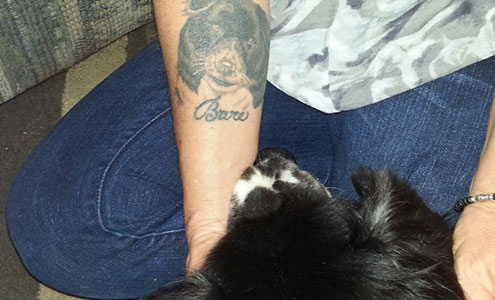
Frequently Asked Questions...
- What does hospice care entail?
- When the decision has be reached not to pursue further diagnostics, testing or treatment, the focus becomes making the patient as comfortable as possible. Pain management medications, acupuncture, and massage therapy are just some of the modalities that can be used to improve the quality of the pet’s remaining time with us.
- How do I know it’s the right time to say goodbye?
- The decision to euthanize a family pet can be very stressful and difficult. “Is it the right time?”, “Are we making the right decision?” “Is s/he ready to go?” are common questions pet owners ask themselves at this point in their pet’s lives. Unless the animal is obviously suffering, there sometimes are no clear answers. We will be happy to discuss your pet’s unique circumstances and whether or not it is time to make that decision. Sometimes something as simple as pain management (see Hospice Care above) can improve their quality of life in the short term.
- Why should I consider at-home euthanasia instead of at the vet’s office?
- Some owners might be hesitant to take their pet to the veterinarian’s office for the euthanasia, as the animal might have long associated that place with pain or discomfort. Many would rather have their pet’s last moments be at home, in an environment they feel safe and comfortable in. Also the physical logistics of taking a large dog home or to a specific crematory after visiting the vet’s office might be challenging.
- Can you describe the procedure and what I should expect?
- After completing the necessary paperwork, the patient will receive 2 injections. The first is anesthesia (usually administered under the scruff behind the neck). Within 10 minutes the patient will fall into a deep sleep, often while being held in the owner’s arms. The patient’s eyes might still be open, but s/he will be checked for deep pain reflex to assure s/he is fully unconscious. The second injection is a concentrated barbiturate and will be administered through a butterfly catheter in the hind leg, stopping the patient’s heart within a couple minutes. The entire process is very peaceful and with minimal (if any) pain.
Occasionally unexpected reactions may occur. The most common ones are described below:
- Initial Injection: Though most patients do not feel the first injection being administered, there can be slight discomfort associated with it. If discomfort is felt, it is transient and disappears very quickly.
- Anesthetic Reaction: It is impossible to predict how individual patients will respond to medications. Age, medical condition (kidney failure, history of seizures, etc.), current medications and genetic predilection may all factor into it. Occasionally some patients may have a “mini seizure” when the first sedative takes effect. It is usually over within 30 seconds and often it appears the patient is already unconscious when it happens. A peaceful sleep shortly follows it.
- Route of Final Injection: Small, aged or dehydrated veins may be difficult to catheterize. An attempt is always made but if it is unsuccessful, the final injection would be given through the side of the chest. The patient does not feel the injection and its effects are very quick.
- Elimination: Most patients often urinate or deficate after being euthanized, and it is important to keep this in mind when deciding on the location of the procedure.
- I’m having a very hard time dealing with my loss. Where can I turn to?
- There are numerous resources available for owners dealing with loss and grief. Please check back soon for a comprehensive listing.

